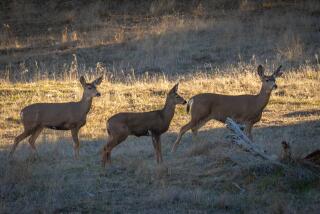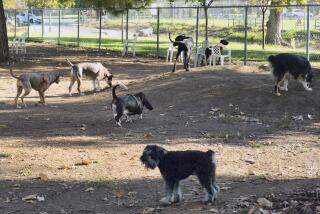Hunters Not Deterred by Disease Threat
- Share via
WAUSAU, Wis. — State wildlife officials over the weekend sought a grim bounty -- the heads of 50,000 deer -- to determine how far chronic-wasting disease has spread.
But many hunters were choosing not to part with their trophies Saturday.
In what the Wisconsin Department of Natural Resources described as the largest wildlife disease survey ever conducted, the department set up 200 collection sites where wildlife experts sawed off the heads of deer brought in by hunters.
“There has never been anything like this in the history of wildlife management in Wisconsin or really anywhere,” said Rick Weide, a department wildlife biologist at a Wausau collection site where he inspected animals, including a 3-year-old whitetail buck shot Saturday by Darlene Svacina.
The deer lacked signs of infection such as pus around the eyes and antlers and a lack of meat around the ribs, but it will take several weeks to conduct more definitive tests on brain tissue.
“I am thinking the disease is not up this far north, but I want to be sure,” Svacina said. “We are just going to cut him up at home, put him in the freezer and wait for the test results to come in.”
Chronic-wasting disease creates sponge-like holes in a deer’s brain, causing it to grow thin, behave abnormally and die. Experts say there is no evidence the disease can infect humans, but the World Health Organization advises people not to eat any part of a deer with evidence of the incurable, fatal disease.
The state is making an unprecedented attempt to kill all deer -- at least 25,000 of them -- in a 411-square-mile area west of Madison where the disease was first seen in the state.
But many hunters appeared unconcerned about the disease. O-W Sports and Liquor in Owen registered 177 deer by late afternoon, but only 30 heads were donated, owner Jackie Reinke said.
“There are so many bucks being shot and they don’t want to give up the horns,” she said.
Department of Natural Resources spokeswoman Laurel Steffes said reports on the head collections Saturday were mixed. Some stations did not have as many as they wanted, and others were doing fine.
“We really need to hammer the message that we really need those deer,” she said.
The state announced in February that it found chronic-wasting disease in three deer killed last fall west of Madison. It was the first time the disease was found east of the Mississippi.
More to Read
Sign up for Essential California
The most important California stories and recommendations in your inbox every morning.
You may occasionally receive promotional content from the Los Angeles Times.










